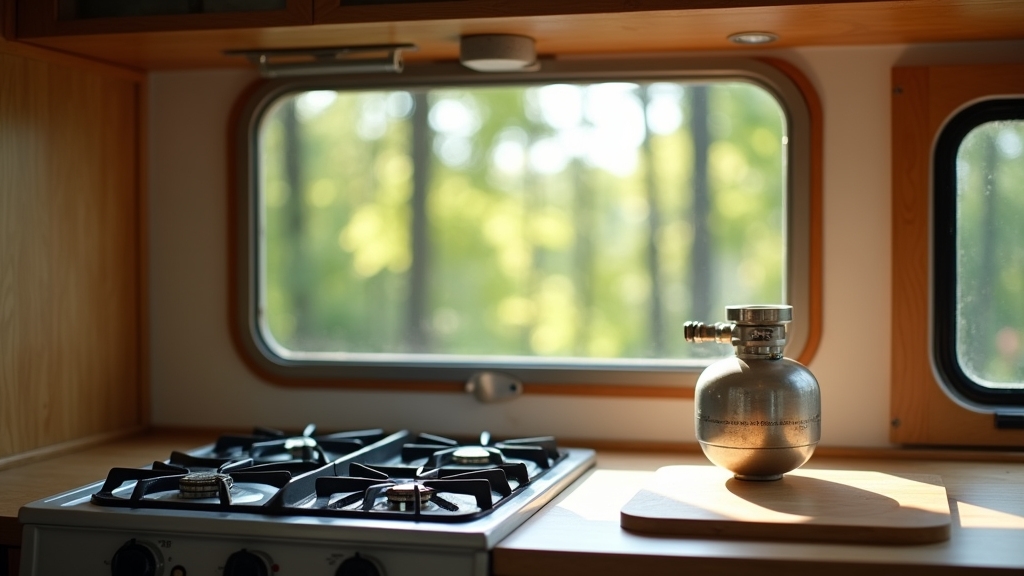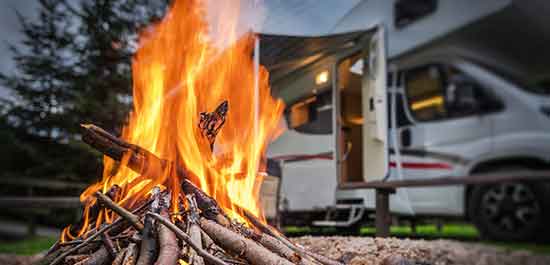Last Updated on August 25, 2025
If you’re using a standard 20-pound propane tank in your RV, expect it to last about 8 to 12 hours of continuous use, depending on appliance demand like your furnace or stove.
Larger tanks hold more fuel and stretch usage considerably, while colder temperatures can increase consumption. Proper tank selection, efficient appliance use, and safe handling directly affect how long your propane supply lasts.
Understanding these factors will help you optimize your propane’s performance and duration on the road.
Key Takeaways
- A 20-pound propane tank holds about 5 gallons and lasts 8-12 hours with continuous furnace use.
- Propane consumption varies by appliance type, usage frequency, and seasonal temperature changes.
- Larger tanks (30-40 lbs or 100 lbs) provide longer duration, reducing refill frequency.
- Furnace operation uses roughly ¼ gallon per hour; cooking and refrigeration use less fuel intermittently.
- Cold weather increases propane use due to higher heating demand and lower tank pressure.
Common Sizes of RV Propane Tanks
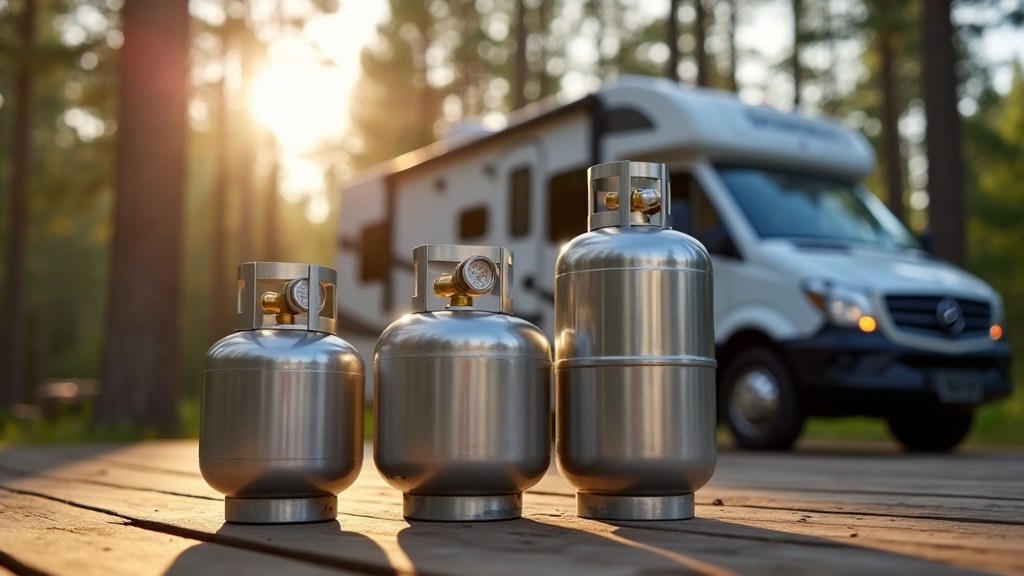
When choosing an RV propane tank, you’ll typically encounter three main categories: portable DOT cylinders, permanent ASME tanks, and residential-style tanks used in larger RVs or campgrounds.
Portable DOT tanks range from 20 to 40 pounds, holding about 4 to 8 gallons of propane. They’re vertical and often mounted in pairs for convenience.
Portable DOT tanks hold 4 to 8 gallons of propane and are often paired vertically for easy use.
Permanent ASME tanks are mounted horizontally under motorhomes. They vary from 20 pounds up to 100 gallons (420 pounds). These tanks offer extended capacity for long trips. Consider the dimensions range of these tanks to ensure they fit properly under the RV.
Residential-style tanks, used in large RVs or campgrounds, include 120-, 250-, and 500-gallon sizes. These require permanent installation and must meet strict safety regulations.
Your choice depends on space, weight capacity, and usage needs. Each tank type offers specific advantages in portability, volume, and installation requirements.
Factors Affecting Propane Consumption in RVs
You’ll notice propane consumption varies widely based on which appliances you use and how often you run them.
Seasonal temperature changes also play a significant role. Colder conditions force your furnace to operate longer, increasing propane usage. Proper maintenance and efficiency of appliances can help optimize fuel use.
Additionally, the size of your propane tank limits how long you can run these systems before needing a refill. Propane containers are only filled to 80% capacity for safety, which affects the total available fuel.
Other factors such as appliance efficiency and usage habits can also impact overall propane consumption in your RV. Understanding your RV’s load rating can provide insights into managing fuel and energy needs effectively.
Appliance Usage Impact
Although propane consumption varies widely, understanding how your RV appliances use fuel is essential for accurate tank life estimates. Each appliance has distinct BTU ratings—furnaces consume between 20,000 and 40,000 BTU/hr, stoves 10,000 to 25,000 BTU/hr, and water heaters roughly 10,000 to 20,000 BTU/hr.
Your total consumption depends on how long and how often you run each device. For example, prolonged furnace use quickly depletes propane, while intermittent cooking has variable impact. Applying efficient maintenance to your appliances can reduce propane usage by improving combustion and performance.
Combined appliance load matters: simultaneous heating, cooking, and hot water use accelerates tank depletion. Appliance efficiency also influences consumption; well-maintained, newer units use less fuel. Additionally, factors like burner size, ignition type, and cycling behavior affect real-time propane use.
Tracking these variables helps you estimate propane duration more precisely and manage usage effectively. Know that RV propane tanks are filled to 80% capacity to allow for fuel expansion, which impacts the total usable propane available.
Seasonal Temperature Effects
Because propane’s physical properties react to seasonal temperature changes, you must consider how cold weather affects both fuel availability and appliance performance in your RV.
Cold contracts propane, lowering tank pressure and causing gauges to underestimate fuel levels. This pressure drop restricts flow to furnaces and water heaters, risking shutdowns and reduced heating efficiency.
However, reliable delivery companies use volume correction devices to ensure accurate refills even in cold weather. Additionally, some RV owners install weather-resistant ladder racks to carry extra propane tanks securely for extended trips.
Additionally, increased heating demand in colder months accelerates propane consumption. This means you will use propane faster when temperatures drop. To mitigate these effects, insulation and external heating pads help maintain adequate tank pressure.
| Factor | Impact |
|---|---|
| Low Temperature | Decreased tank pressure, flow issues |
| Increased Heating Demand | Higher propane consumption |
| Insulation & Heating Solutions | Stabilize pressure, improve appliance reliability |
Tank Size Limitations
When selecting a propane tank for your RV, you must consider size limitations that affect both fuel capacity and usage patterns. DOT cylinders are smaller, portable tanks ranging from 20 to 33 lbs. In contrast, ASME tanks are larger, permanently installed units that can hold up to 420 lbs.
These size differences influence refill frequency, weight, and storage space. ASME tanks require regular inspection, while DOT cylinders must be recertified every 5-10 years, adding to maintenance considerations. Maintaining proper pressure levels in your propane system is essential for safety and efficiency.
Additionally, regulatory restrictions limit how many tanks you can carry especially in enclosed compartments. This can impact your overall propane capacity and how you plan your trips.
Keep in mind that smaller tanks (20-lb) are easier to exchange but require frequent refilling. Larger ASME tanks reduce refill intervals but add weight and complexity. Safety regulations also restrict tank sizes and transport quantities, which will affect your choice.
Typical Duration of Propane Supply by Tank Size
You’ll find that propane supply duration varies directly with tank size and your specific usage patterns. Smaller tanks like 20 or 30 pounds suit short trips or light appliance use, lasting a couple of days.
Choosing the right tank also depends on your load capacity needs to ensure safety and efficiency. Larger tanks extend that duration considerably, providing longer-term supply. Understanding how your consumption matches tank capacity helps you plan refills.
This also allows you to manage energy efficiently. Most motorhomes use fixed ASME tanks that require specialized refilling stations.
Tank Size Impact
Understanding how tank size impacts propane duration is crucial for efficient RV management. Larger tanks extend your propane supply, reducing refill frequency and enabling longer trips or heavier appliance use. You’ll find that typical RV tanks range from 20 to 100 pounds, with fill limits at 80% capacity for safety and expansion.
A 20-pound tank holds about 5 gallons, powering appliances roughly 8-12 hours continuously. This size is ideal for short trips or as a backup. Tanks between 30 and 40 pounds store 6 to 9 gallons. They last approximately 12-20 hours and fit the needs of most RV users. A 100-pound tank contains about 19 gallons.
It can last multiple days under moderate use, making it perfect for extensive heating, cooking, and refrigeration. For larger or more energy-demanding setups, similar to residential or commercial use, propane tanks can be selected based on appliance demand and size requirements, ensuring adequate supply for all needs home size and appliance demand.
Choosing the right tank size involves balancing your available space, weight constraints, and propane duration requirements efficiently. Additionally, considering the energy consumption rate of your appliances helps optimize tank size selection.
Usage Patterns Effects
Since propane consumption depends heavily on how you operate your RV appliances, estimating tank duration requires careful tracking of each device’s run time and BTU demand. For example, a 14-gallon tank with appliances totaling 43,800 BTU/hour lasts about 29 hours.
High-demand devices like furnaces consume roughly ⅓ gallon per hour if run continuously, drastically reducing tank life. Intermittent use of stoves or water heaters extends duration proportionally. Cold weather increases BTU consumption by 50% or more, shortening propane supply.
To optimize usage, prioritize essential appliances and adjust run times based on actual consumption mid-trip. Using smart devices such as battery tenders can help maintain your RV’s electrical systems while managing propane appliance use.
Remember, baseline devices like propane refrigerators run cyclically, adding to total consumption. Accurate monitoring and selective operation help you manage propane efficiently within your tank’s capacity.
Additionally, propane tanks are only filled to 80% capacity to allow for safe thermal expansion, which affects the actual usable volume available during your trip.
Impact of Seasonal Temperature on Propane Use
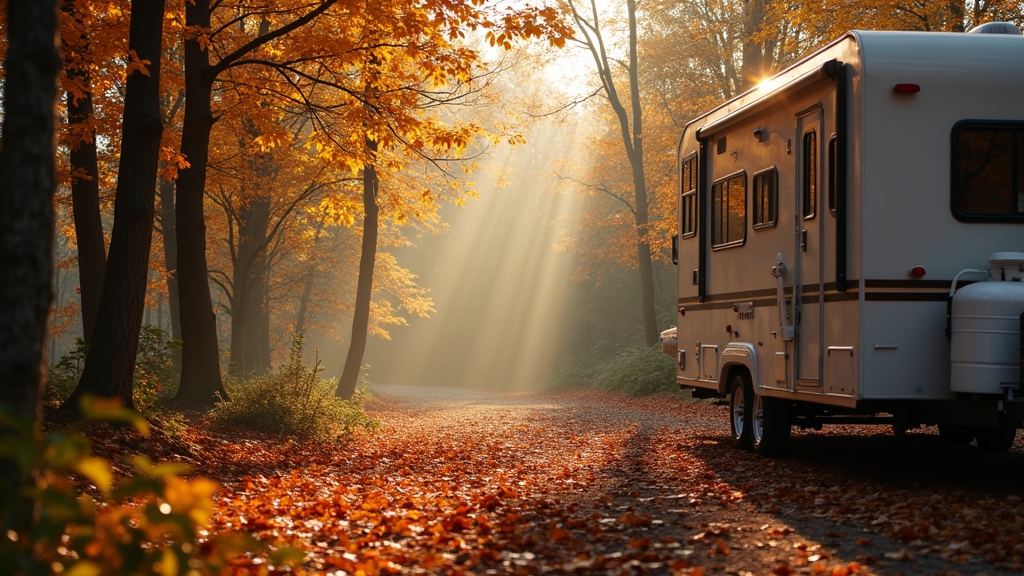
Although propane remains effective in a range of temperatures, seasonal drops considerably affect its performance and consumption in your RV. Cold temperatures reduce propane’s volume and internal pressure, which can cause your gauge to underestimate fuel levels. Relying on weather-resistant materials and proper equipment maintenance ensures more accurate readings and safer operation.
This lowered pressure sometimes impairs appliance function, especially during prolonged cold spells when vaporization slows. Additionally, propane consumption spikes as your furnace and water heater run longer to maintain comfort.
To manage these effects, consider monitoring tank pressure carefully, knowing it may read low in cold weather. Many RV propane systems include GasStop safety devices that may shut off flow if pressure drops too low in cold conditions.
Using proper insulation and skirting can reduce heat loss and propane demand. Scheduling propane deliveries ahead of winter helps avoid running out during peak use. Understanding these seasonal impacts helps you maintain efficient and reliable propane use in your RV.
Differences Between DOT and ASME Propane Tanks
Propane tanks used in RVs come primarily in two types: DOT and ASME, each designed to meet different regulatory standards and practical needs.
DOT tanks comply with Department of Transportation rules, focusing on portability and transportation safety. They’re vertical, lightweight cylinders, commonly 20 or 33 pounds, mounted externally for easy removal and refilling.
These tanks are the most widely available size for refilling or exchanging at grocery stores, gas stations, and propane suppliers. Their design allows for quick setup and replacement, making them convenient for frequent travel.
ASME tanks meet American Society of Mechanical Engineers standards, built for permanent installation with thicker steel walls. They’re generally horizontal and heavier. These tanks range from 20 pounds up to 100 gallons and are fixed under motorhomes for durability and larger capacity.
DOT tanks require recertification every 5 years after 12 years, while ASME tanks do not. You’ll find DOT tanks ideal for towable RVs needing flexible fuel management, whereas ASME tanks suit motorhomes demanding a stable, long-lasting propane supply.
Propane Usage for Heating, Cooking, and Refrigeration
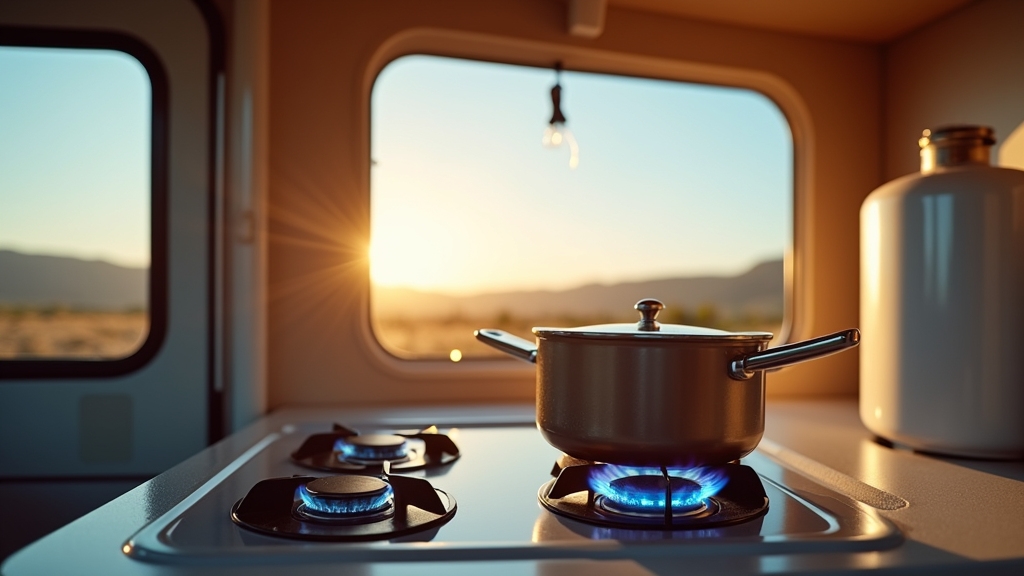
Understanding how much fuel your RV appliances consume is essential for managing propane supply effectively. Your furnace, cooking stove, and refrigerator each draw propane at different rates, influencing how long your tank lasts.
Knowing your RV appliances’ propane usage helps you manage fuel supply efficiently.
For example, a 20,000 BTU furnace running continuously consumes roughly one-quarter gallon per hour, depleting a 20 lb tank in about 22 hours. Most RVs utilize 20 lb or larger tanks depending on setup and needs, which affects overall duration. Choosing the correct heating capacity ensures efficient propane use and optimal warmth.
Cooking appliances vary from 5,000 to 20,000 BTUs per hour but typically use propane intermittently, reducing overall consumption. Refrigerators operating on propane use between 1,000 and 3,000 BTUs per hour, with higher ambient temperatures increasing fuel use.
Furnaces consume the most during cold weather due to continuous cycling. Cooking propane use depends on frequency and duration. Refrigerators require continuous propane when off-grid without electric power. Accurately summing appliance BTUs helps you estimate propane duration precisely.
Strategies for Extending Propane Tank Life
Managing how you use propane appliances directly affects how long your tank lasts, but you can also take steps to extend the overall life of your propane tank and system. Regularly inspect your tank for manufacture and requalification dates, and adhere to required testing intervals.
Replace regulators every 10-15 years to maintain safe operation. Use extended stay accessories designed for RV propane tanks to increase capacity without frequent refills, ensuring proper installation to avoid leaks.
Optimize propane consumption by lowering thermostat settings and maintaining heating appliances for efficiency. Remember that propane tanks must be kept upright with the valve handle on top to ensure proper vapor flow and prevent liquid propane from entering your system.
Choose tank sizes aligned with your typical usage and trip length, considering environmental factors. Store tanks upright in ventilated areas, avoid extreme temperatures, and secure them during travel to prevent damage.
Safe Handling and Refilling Practices for RV Propane
When transporting or storing your RV’s propane cylinders, always keep them upright to prevent liquid propane from entering gas lines and damaging the system.
Secure cylinders with straps or place them in stable bases to avoid tipping. Never use or refill propane tanks while driving. Always turn off the main supply valve before refilling.
For safe handling and refilling, follow these essential practices:
- Have refills performed by certified professionals at authorized stations. Ensure tanks are inspected for damage before filling.
- Store extra cylinders in well-ventilated compartments or outside boxes with airflow to prevent gas accumulation.
- Use propane leak detectors regularly. If you smell gas, immediately shut off the supply, ventilate the area, and seek expert help. Propane is flammable and safe when used properly, so vigilance is critical.
Choosing the Right Propane Tank for Your RV Needs
Because propane needs vary widely depending on your RV’s size and usage, selecting the right tank is essential for efficiency and convenience. For small to medium RVs, 20- or 33-pound DOT tanks offer portability and ease of refilling, holding about 5 and 8 gallons of propane, respectively.
If you require longer usage without frequent refills, consider an ASME tank, ranging from 100 to 420 pounds, permanently mounted under motorhomes.
Remember, tank weight impacts payload and handling, so balance capacity with your RV’s storage limitations. Propane weighs approximately 4.2 pounds per gallon, so full tanks add significant weight to your vehicle.
Also, verify compatibility with your RV’s fittings and observe safety standards. Frequent users benefit from larger ASME tanks, while occasional campers will appreciate the flexibility and availability of smaller DOT cylinders.
Frequently Asked Questions
Can Propane Tanks Be Refilled at Any Gas Station?
You can’t just pour water into any cup and expect it to hold—it’s the same with propane tanks. Not every gas station can refill your RV’s propane tank. Many only swap smaller grill cylinders or lack the specialized equipment for large or fixed RV tanks.
You’ll need to find dedicated propane refill stations or certain hardware stores that meet safety and certification standards to get your tank properly refilled. Always call ahead to confirm.
How Should I Store Propane Tanks When Not in Use?
You should store propane tanks outdoors in a well-ventilated, shaded area, keeping them upright to maintain valve function. Avoid enclosed spaces, direct sunlight, or temperatures above 120°F.
Always turn off valves completely before storage and secure tanks to prevent tipping. Keep them away from heat sources, combustible materials, and high-traffic zones. For long-term storage, protect tanks from moisture, label them clearly, and guarantee easy emergency access.
Are There Any Signs of Propane Leaks to Watch For?
Watch for whiffs of rotten eggs or sulfur scents—these signal significant leaks. You’ll notice unusual appliance actions, like flickering pilot lights or failed ignitions. Listen for whistling sounds near regulators or connections.
Inspect visually for frost build-up or cracked fittings. Use soapy water to spot bubbling at joints, indicating leaks. Increased propane use despite steady habits, error codes on appliances, or swarming insects near tanks also warn you about leaks.
Can I Use Regular Cooking Propane for My RV Heater Safely?
Absolutely, you can use regular cooking propane in your RV heater without turning your trip into a disaster movie. Both types are chemically identical, offering the same energy output.
Just make certain your tank and fittings meet RV safety standards, and always check for leaks. Use the right regulators and maintain your system properly. With these precautions, cooking with propane fuels your heater efficiently and safely, keeping you warm without worry.
Optimizing Propane Performance for Longer Adventures
Understanding how long propane lasts in your RV is like gauging fuel in a car—it depends on your tank size, usage, and conditions. By considering factors like seasonal temperature and appliance demands, you can better estimate consumption and choose the right tank.
Employ safe handling and refilling practices while using strategies to extend tank life. With precise management, you’ll ensure a reliable propane supply for heating, cooking, and refrigeration on every trip.

